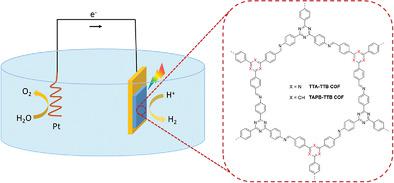当前位置:
X-MOL 学术
›
Adv. Mater. Interfaces
›
论文详情
Our official English website, www.x-mol.net, welcomes your feedback! (Note: you will need to create a separate account there.)
2,4,6‐Triphenyl‐1,3,5‐Triazine Based Covalent Organic Frameworks for Photoelectrochemical H2 Evolution
Advanced Materials Interfaces ( IF 4.3 ) Pub Date : 2021-02-16 , DOI: 10.1002/admi.202002191 Chunhui Dai 1, 2 , Ting He 3 , Lixiang Zhong 4 , Xingang Liu 1 , Wenlong Zhen 4 , Can Xue 4 , Shuzhou Li 4 , Donglin Jiang 3 , Bin Liu 1
Advanced Materials Interfaces ( IF 4.3 ) Pub Date : 2021-02-16 , DOI: 10.1002/admi.202002191 Chunhui Dai 1, 2 , Ting He 3 , Lixiang Zhong 4 , Xingang Liu 1 , Wenlong Zhen 4 , Can Xue 4 , Shuzhou Li 4 , Donglin Jiang 3 , Bin Liu 1
Affiliation

|
Photoelectrochemical water splitting over semiconductors offers a sustainable solar light conversion technique capable of alleviating worldwide energy crisis. Conjugated polymers have recently received increasing attention as a class of promising photoelectrode materials due to their advantages of earth‐abundance, non‐toxicity, light weight, and molecularly tunable functionalities, etc. However, the development of highly efficient organic photoelectrodes remains a big challenge. In this study, two covalent organic frameworks (COFs) incorporated 2,4,6‐triphenyl‐1,3,5‐triazine are demonstrated as excellent photocathodes for H2 production. By introducing 2,4,6‐triphenylbenene to properly create donor/acceptor pairs within COF, a significantly enhanced visible‐light photocurrent of TAPB‐TTB COF (110 µA cm−2) compared to TTA‐TTB COF (35 µA cm−2) at 0 V versus reversible hydrogen electrode (RHE) is obtained without adding organic sacrificial agent and metal cocatalysts (>420 nm). The enhanced photocurrent density is attributed to the narrowed bandgap and improved charge transfer by intramolecular donor–acceptor combination. This work highlights the great promising applications of crystalline donor–acceptor COFs as high‐efficiency organic photoelectrode for water splitting.
中文翻译:

基于2,4,6-三苯基-1,3,5-三嗪的共价有机骨架,可用于光电化学制氢
半导体上的光电化学水分解技术提供了一种可持续的太阳光转换技术,能够缓解全球能源危机。共轭聚合物由于其富地球,无毒,重量轻和分子可调功能等优点而作为一类有前景的光电极材料受到越来越多的关注。但是,高效有机光电极的开发仍然是一个巨大的挑战。 。在这项研究中,两个结合有2,4,6-三苯-1,3,5-三嗪的共价有机骨架(COF)被证明是生产H 2的优良光电阴极。通过引入2,4,6-三苯并苯在COF中正确创建供体/受体对,可显着增强TAPB-TTB COF的可见光光电流(110 µA cm-2)相比TTA-TTB COF(35μA厘米-2)在0V与可逆氢电极(RHE),但不加入有机牺牲剂和金属助催化剂(> 420纳米)获得。光电流密度的提高归因于分子内供体-受体组合的带隙变窄和电荷转移的改善。这项工作突出了晶体供体-受体COF作为高效的水分解有机光电极的巨大前景。
更新日期:2021-04-09
中文翻译:

基于2,4,6-三苯基-1,3,5-三嗪的共价有机骨架,可用于光电化学制氢
半导体上的光电化学水分解技术提供了一种可持续的太阳光转换技术,能够缓解全球能源危机。共轭聚合物由于其富地球,无毒,重量轻和分子可调功能等优点而作为一类有前景的光电极材料受到越来越多的关注。但是,高效有机光电极的开发仍然是一个巨大的挑战。 。在这项研究中,两个结合有2,4,6-三苯-1,3,5-三嗪的共价有机骨架(COF)被证明是生产H 2的优良光电阴极。通过引入2,4,6-三苯并苯在COF中正确创建供体/受体对,可显着增强TAPB-TTB COF的可见光光电流(110 µA cm-2)相比TTA-TTB COF(35μA厘米-2)在0V与可逆氢电极(RHE),但不加入有机牺牲剂和金属助催化剂(> 420纳米)获得。光电流密度的提高归因于分子内供体-受体组合的带隙变窄和电荷转移的改善。这项工作突出了晶体供体-受体COF作为高效的水分解有机光电极的巨大前景。








































 京公网安备 11010802027423号
京公网安备 11010802027423号